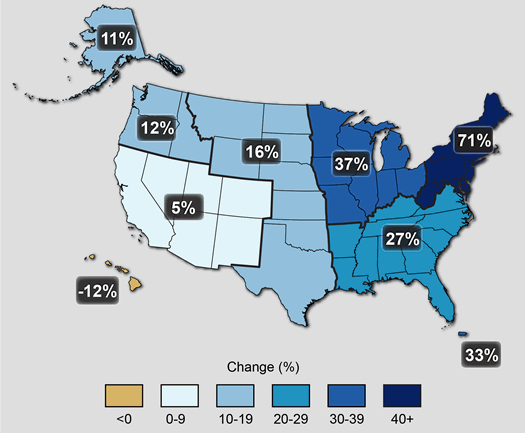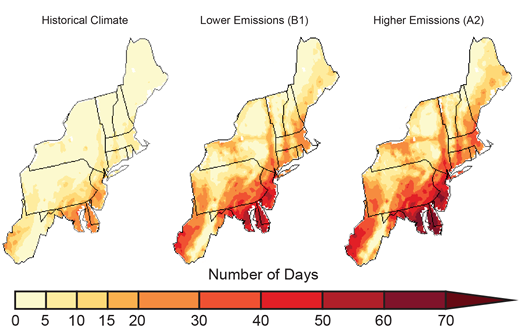A future of more extremes

Very heavy precipitation events -- like Hurricane Irene in 2011, which flooded many areas of the region -- are becoming more common in the Northeast, according to the National Climate Assessment.
Unusually large rainfall events that result in flooding. Early spring that results in fruit tree blossoms getting zapped by frost. Exceptionally hot days in places where people haven't typically used much air conditioning.
Those are a few examples of events that are projected to become more common in the Northeast due to climate change, according to a report out today called the National Climate Assessment. It's the product of a federally-organized effort to "understand, assess, predict, and respond to human-induced and natural processes of global change."
The report looks at the whole country, but it also breaks down what's happened already -- and what's predicted to happen -- regionally. So, let's take a look at some of the bits for the Northeast...
A quick note: Many of the possible effects discussed in the report are projects based on models and observed data. They're guesses, essentially -- guesses built on a lot of observation and scientific thinking, but they're not certainties. The report points out that many projects are in ranges of possibilities, and it includes links to more info. If you're curious about some of the thinking behind the projections, it's worth going to the report to get some of the background.
What's happened already

Observed change in very heavy precipitation, from the report: "The map shows percent increases in the amount of precipitation falling in very heavy events (defined as the heaviest 1% of all daily events) from 1958 to 2012 for each region of the continental United States. ... The changes shown in this figure are calculated from the beginning and end points of the trends for 1958 to 2012. (Figure source: updated from Karl et al. 2009)."
+ Temperatures in the Northeast have risen almost 2 degrees Fahrenheit since 1895.
+ Precipitation has increased 10 percent in that time.
+ And the extremes have gotten more extreme: "The Northeast has experienced a greater recent increase in extreme precipitation than any other region in the United States; between 1958 and 2010, the Northeast saw more than a 70% increase in the amount of precipitation falling in very heavy events (defined as the heaviest 1% of all daily events)."
An example of recent extreme precipitation: Hurricane Irene, which as you know, caused devastating flooding in parts of this region. (The report notes that "individual hurricanes cannot be directly attributed to climate change.")
Projected changes

Projected Increases in the Number of Days over 90°F., from the report: "Projected increase in the number of days per year with a maximum temperature greater than 90°F averaged between 2041 and 2070, compared to 1971-2000, assuming continued increases in global emissions (A2) and substantial reductions in future emissions (B1). (Figure source: NOAA NCDC / CICS-NC)."
The short story: temperatures are projected to continue rising. The somewhat longer version:
As in other areas, the amount of warming in the Northeast will be highly dependent on global emissions of heat-trapping gases. If emissions continue to increase (as in the A2 scenario), warming of 4.5ºF to 10ºF is projected by the 2080s; if global emissions were reduced substantially (as in the B1 scenario), projected warming ranges from about 3ºF to 6ºF by the 2080s.
Under both emissions scenarios, the frequency, intensity, and duration of heat waves is expected to increase, with larger increases under higher emissions (Ch. 2: Our Changing Climate). ...
The frequency, intensity, and duration of cold air outbreaks is expected to decrease as the century progresses, although some research suggests that loss of Arctic sea ice could indirectly reduce this trend by modifying the jet stream and mid-latitude weather patterns.
And, we're probably looking at wetter weather, especially in the winter and spring, though "projections of precipitation changes are less certain than projections of temperature increases." And the risk of drought in summer and fall will probably increase.
Possible effects
Making projections about possible effects of the changing climate are tricky, in part because so many things are interdependent on each other. A few of the projected possibilities:
+ Rising temperatures will probably result in warmer winters, but the risk of frost and freeze damage "has paradoxically increased over the past decade" because of early season or unusual warm periods that prompt crops to leaf or bloom early and then become subject to late frost, like what happened to fruit crops upstate in 2012.
+ Warmer temperatures could mean longer growing seasons, but the increased chance of summer droughts could hurt crops.
+ While warmer temperatures could benefit some species -- like some hardwood trees -- mid-summer drought could negate some of that benefit. And even as those hardwood trees benefit from warmer temps, forests of spruce and fir in the Adirondacks could suffer.
+ Uncertainty over pests -- warmer, wetter weather could result increased Lyme disease incidence and the widening of mosquito ranges.
+ Warmer winters could mean lower heating bills, but hotter summers could be a problem for areas that traditionally haven't had to rely much on air conditioning: "Some areas of northern New England, near the Canadian border, are projected to shift from having less than five to more than 15 days per year over 90°F by the 2050s under the higher emissions scenario (A2) of heat-trapping gases."
Say Something!
We'd really like you to take part in the conversation here at All Over Albany. But we do have a few rules here. Don't worry, they're easy. The first: be kind. The second: treat everyone else with the same respect you'd like to see in return. Cool? Great, post away. Comments are moderated so it might take a little while for your comment to show up. Thanks for being patient.
... said KGB about Drawing: What's something that brought you joy this year?